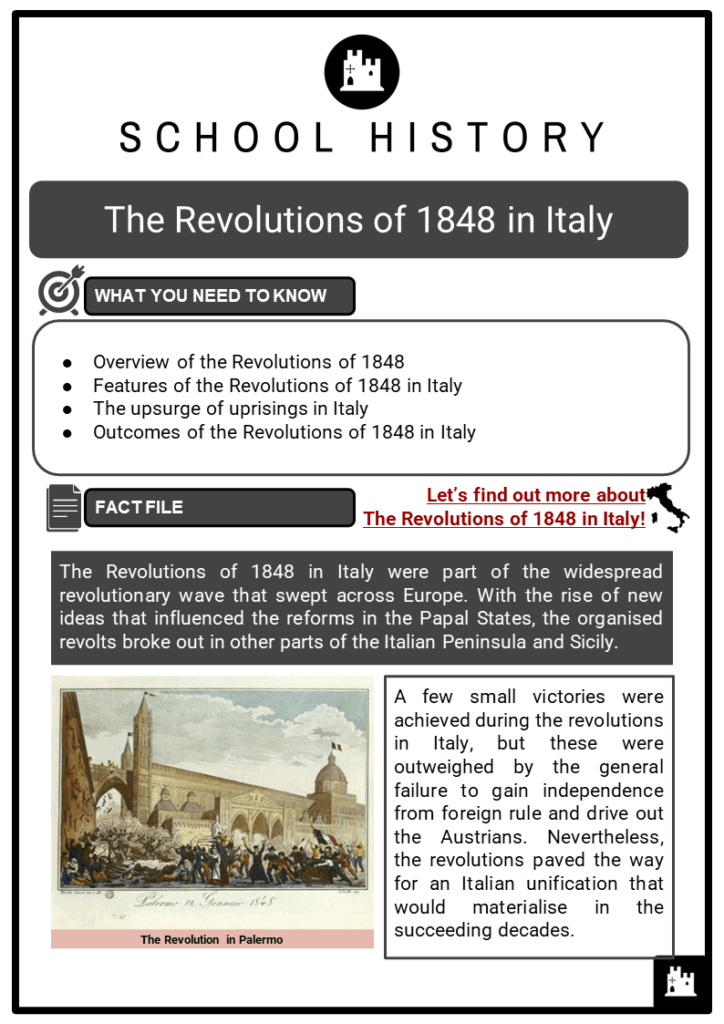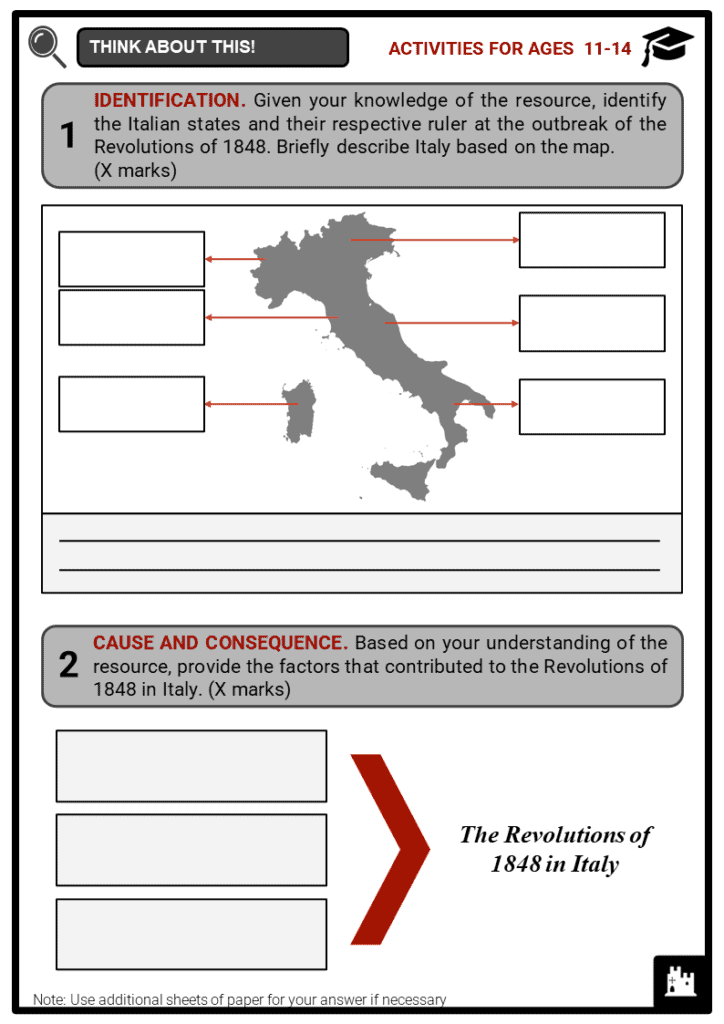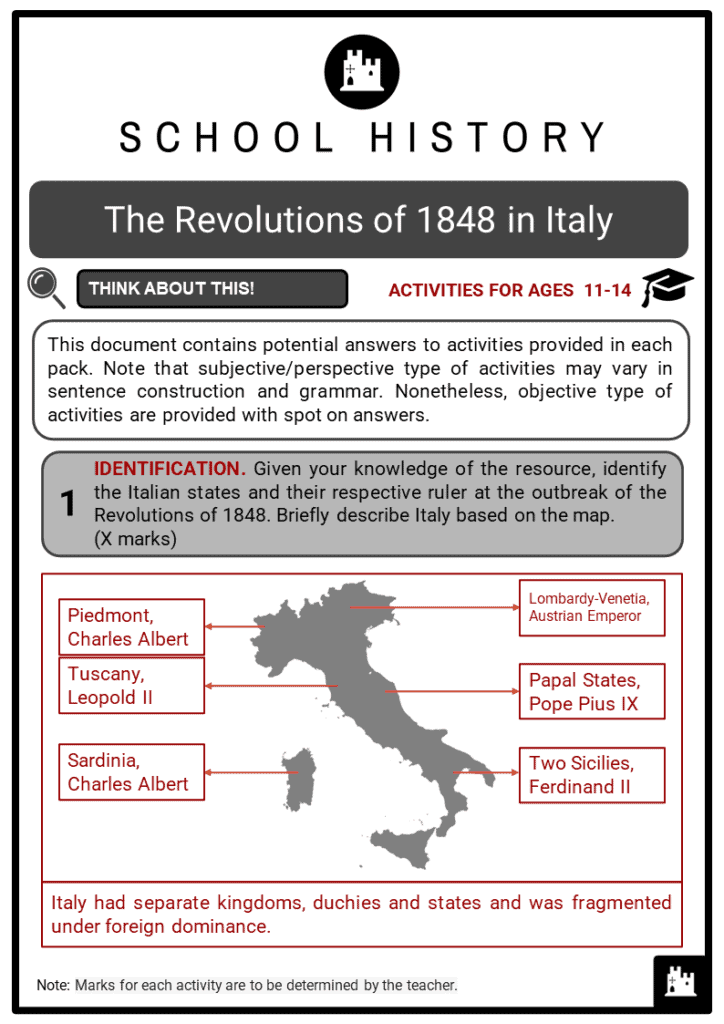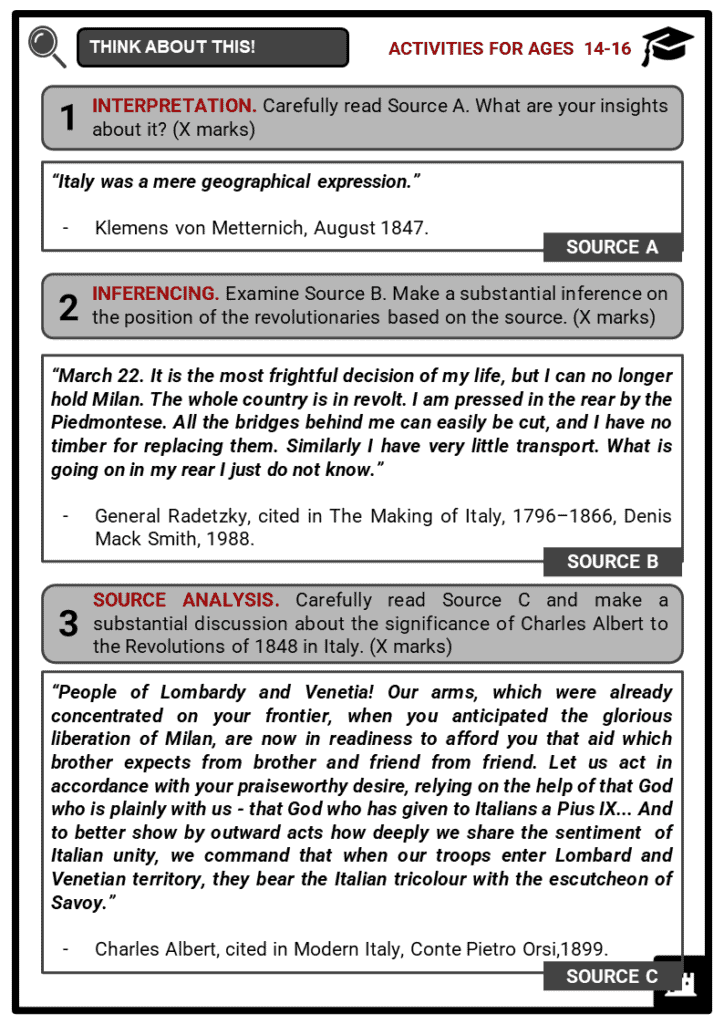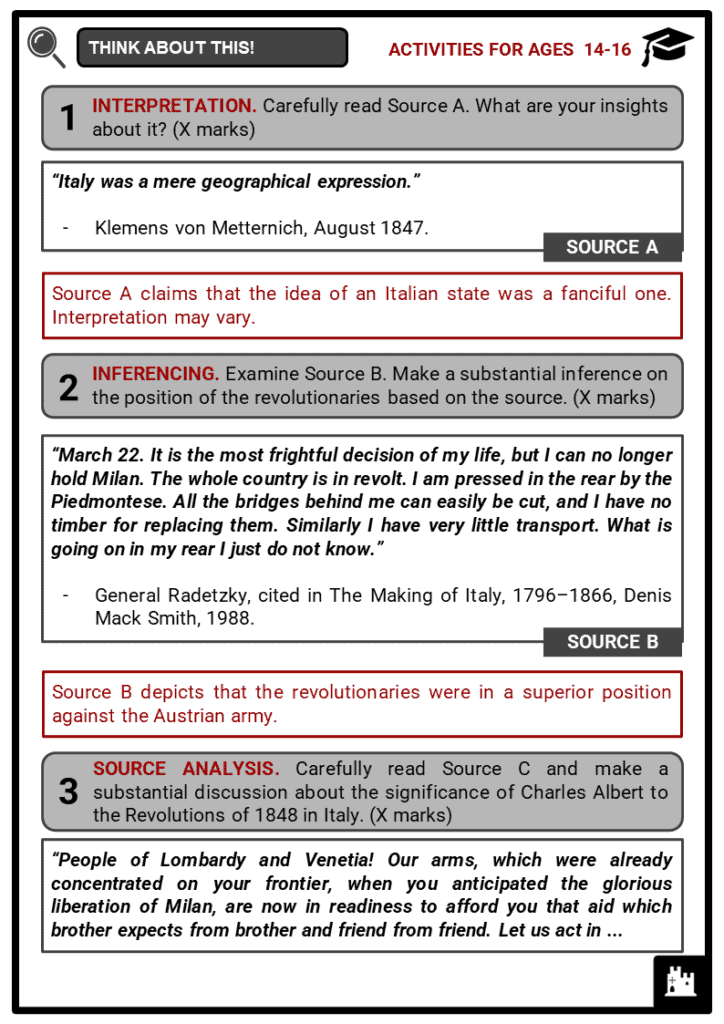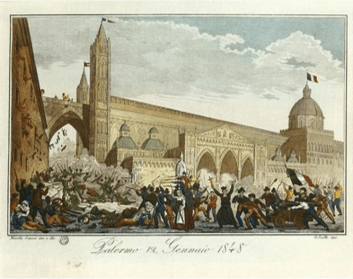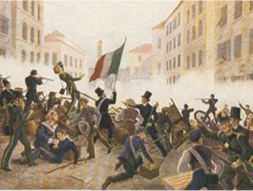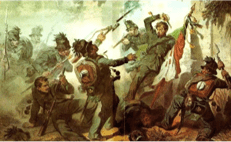Download The Revolutions of 1848 in Italy Worksheets
Do you want to save dozens of hours in time? Get your evenings and weekends back? Be able to teach The Revolutions of 1848 in Italy to your students?
Our worksheet bundle includes a fact file and printable worksheets and student activities. Perfect for both the classroom and homeschooling!
Table of Contents
Add a header to begin generating the table of contents
Summary
- Overview of the Revolutions of 1848
- Features of the Revolutions of 1848 in Italy
- The upsurge of uprisings in Italy
- Outcomes of the Revolutions of 1848 in Italy
Key Facts And Information
Let’s find out more about The Revolutions of 1848 in Italy!
- The Revolutions of 1848 in Italy were part of the widespread revolutionary wave that swept across Europe. With the rise of new ideas that influenced the reforms in the Papal States, the organised revolts broke out in other parts of the Italian Peninsula and Sicily.
- A few small victories were achieved during the revolutions in Italy, but these were outweighed by the general failure to gain independence from foreign rule and drive out the Austrians. Nevertheless, the revolutions paved the way for an Italian unification that would materialise in the succeeding decades.
Overview of the Revolutions of 1848
- In 1848 and early 1849, Europe witnessed its most widespread revolutionary wave now often referred to as the Springtime of Nations or the Year of Revolution. The increasingly radical widespread protests affected more than fifty countries with France, the states of the German Confederation, Italy, and the Austrian Empire having the most important revolutions. Whilst the uprisings had no significant coordination among their respective revolutionaries, they were brought about by similar contributing factors such as dissatisfaction with the poor governance and the negligence of the European monarchs towards the people, the emergence of new ideas such as nationalism, liberalism, and socialism in Europe, and the shared desire for reform of the middle and working classes. Most of the revolutions of 1848 generally failed and led to the conservatives regaining power. Nevertheless, they effectively catalysed significant reforms in various European states.
Features of the Revolutions of 1848 in Italy
- At the outbreak of the Revolutions of 1848, Italy had separate kingdoms, duchies and states and was fragmented under foreign dominance: the Austrians in the north and the Bourbons in the south. In central Italy, the Pope personally controlled the Papal States. Like the rest of Europe, Italy suffered from economic depression brought about by crop failures and widespread unemployment. The desire to unify Italy was fueled by new ideas that emerged during the period. These conditions led to the Revolutions of 1848 in Italy.
- Aims of the revolutions in Italy
- Break away from the conservative leadership of the Austrians
- Create a united and independent state
- Significant figures of the revolutions
- Giuseppe Mazzini: A native of Genoa, he was a key supporter of the Italian unification. He was a writer who founded a republican group known as the Young Italy that helped spread liberalism.
- Pope Pius IX: He replaced his conservative predecessor in 1846. He declared amnesty to political prisoners and exiles of the Papal States and presented himself as a liberal pope.
- Charles Albert: He was the liberal monarch of Piedmont, Genoa, Sardinia, Nice and Savoy. He had the potential and resources to build a strong army to stand up to the Austrians.
- Klemens von Metternich: He was the Austrian foreign minister who saw Italian nationalism and liberalism as a threat to the Austrian Empire.
- Joseph Radetzky von Radetz: He was the Austrian general commissioned to lead the army against the revolutionaries in Italy.
The upsurge of uprisings in Italy
- Inspired by the liberal changes effected in Rome with the election of the new pope, the Revolutions of 1848 in Italy began in Sicily and affected other parts of Italy, particularly the Lombardy–Venetia, Piedmont, Tuscany and the Papal States.
- On 12 January 1848, the people in Sicily demanded for a provisional government that was independent of the mainland.
- The nobles called for the restoration of the constitution of 1812 including the principle of representative democracy and the centrality of Parliament in the government of the state. These changes were initially resisted by Ferdinand II of the Kingdom of the Two Sicilies but were instituted eventually when revolts erupted in Salerno and Naples.
- The king unwillingly granted a constitution that provided for an elected chamber of deputies, but placed no limits on the king's power and authority. Whilst the idea of creating a confederation of all the states of Italy was put forward by the Sicilian Parliament, it did not come to fruition that year.
- Meanwhile, in the Lombardy city of Milan, an anti-Austrian campaign was launched in early January but was successfully dispersed by Austrian troops led by General Radetzky. With harsher taxes in effect in the region, the protests resurfaced on 18 March when news of the uprising in Vienna and the fall of Klemens von Metternich reached the city.
- This became known as the Five Days of Milan. Backed by the clergymen, the people in the city took to the streets, raised barricades and urged the participation of the rural population. With the demonstration of Italian unity, a provisional government of Milan was formed.
- Prior to the revolts in Milan, the other rulers in Italy followed in the footsteps of Ferdinand II in granting a constitution. Leopold II of Tuscany promulgated the Tuscan Constitution of 1848 on 17 February, Charles Albert of Piedmont-Sardinia proclaimed the Statuto Albertino on 4 March, and Pope Pius IX conceded The Fundamental Statute for the Secular Government of the States of the Church on 14 March.
- On the contrary, the Austrian Empire refused to give in to popular pressure and instead, suppressed the opposition in Venice and Milan, as well as the student demonstrations in the university cities of Padua and Pavia. However, the Radetzky-led Austrian army lost nearly all of Lombardy-Venetia a few days after the Five Days of Milan and retreated into the Quadrilateral fortress.
- Charles Albert grew popular as many regarded him as the liberal monarch willing to sacrifice power for the good of the people.
- Although it was a risky decision, Albert declared war on Austria on 23 March. With many people on his side, he led the attack on Quadrilateral fortress from all sides. He gained more support from his fellow princes who pledged to send reinforcements.
- Leopold II, Pope Pius IX and Ferdinand II sent troops to aid the Piedmontese army. This was instrumental in the Austrian defeat and the capture of Peschiera at the Battle of Goito. A few victories were won by the Piedmontese until the tide turned in favour of the Austrians.
- Fearing a religious schism between Austria and Rome, the Pope withdrew his troops from the warfront. Tuscany and Naples followed suit. These damaged the position of the revolutionaries of Piedmont and Lombardy, as well as the popularity of Pope in the Papal States. On 9 August, Albert was forced to sign a truce with Austria known as the Salasco armistice. His army abandoned Lombardy, allowing the return of the Austrians to the region.
- In the Papal States, Count Pellegrino Rossi was appointed by the Pope in September to oversee the government. His biased reforms cost him his life in November. His death was celebrated by the people in Rome. The Pope managed to flee to Gaeta in the Kingdom of the Two Sicilies.
- Without a local government in Rome, the leaders called for an Assembly to be elected on universal manhood suffrage. One of the elected people, Giuseppe Mazzini seized upon the opportunity to help create a new Roman Republic and took the office that was offered him in February 1849.
- Under Mazzini's influence, taxes were abolished throughout the Papal States, freedom of religion was established and a large contingent of troops were sent to aid Albert in his fight against the Austrian Empire. However, these actions turned out to be counterintuitive for the state: the major source of income was eliminated and Rome was left extremely vulnerable to attack with the lack of sufficient troops at home.
- On 12 March 1849, Albert denouncedthe truce with Austria. Although supported by Roman troops, he failed to defend Piedmont against the Austrian army at the Battle of Novara. He abdicated in favour of his eldest son, but the Statuto was preserved.
- Following Novara, the Austrians requested the Venetians to surrender. Venice refused and initially attempted to resist the attacks. On 22 August, the city surrendered after suffering from damages and famine. A couple of months before that, the Papal States fell under the power of the French who aimed to restore the Pope, effectively ending the Roman Republic.
Image sources:

